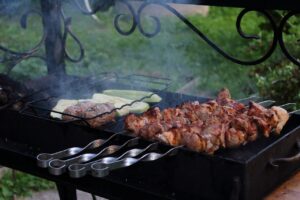Imagine waking up on a lazy Sunday morning, the aroma of sizzling bacon and pancakes wafting through the air. Ah, the joy of cooking on a brand-new griddle!
Whether you’re a novice chef or a seasoned pro, mastering the art of griddle cooking can result in culinary perfection.
To get you started on the right foot, we’ve compiled a list of 5 must-do steps for your first griddle use. Follow these steps, and you’ll be creating mouthwatering dishes in no time!
1. Prepping Your Griddle:
A clean and properly prepped griddle is the foundation of any successful cooking experience. Before firing up your griddle, it’s essential to season it. Seasoning creates a non-stick surface and prevents rust. To season your griddle, follow these simple steps:
- Clean the griddle surface using warm, soapy water and a non-abrasive sponge.
- Rinse thoroughly and pat dry.
- Apply a thin layer of cooking oil or high smoke point oil all over the griddle surface, including the sides and corners.
- Heat the griddle on medium-high heat for around 20 minutes or until the oil smoking point is reached.
- Allow the griddle to cool down and wipe off any excess oil.2. Heat Management:
Properly managing the heat on your griddle is crucial for achieving even cooking and avoiding burned or undercooked food. Most griddles have adjustable temperature controls; however, it’s helpful to know which area of the griddle is hotter or cooler.
**Griddle Temperature Zones:**
| Zone | Temperature | Ideal Use | |-----------------|-----------------------|-----------------| | Hot Zone | 400°F to 450°F | Perfect for searing meats and stir-frying | | Medium Zone | 350°F to 400°F | Great for grilling vegetables and pancakes | | Cooler Zone | 250°F to 350°F | Ideal for toasting buns, melting cheese, and keeping food warm |Remember to preheat the griddle before cooking and consider using oil with a high smoke point to avoid a smoky kitchen.
3. Essential Tools and Ingredients:
To make the most of your griddle cooking experience, you’ll need a few essential tools and ingredients on hand. Here’s a list to get you started:
**Must-Have Griddle Tools:**
- Spatulas (metal or heat-resistant silicone)
- Tongs
- Grill brush or scraper
- Oil dispenser or spray bottle
- Heat-resistant gloves or mitts
**Must-Have Griddle Ingredients:**
- Cooking oil (such as canola, vegetable, or avocado oil)
- Salt and pepper
- Butter
- Fresh herbs and spices (optional)
- Your favorite meats, vegetables, and pancake batter4. Mastering Cooking Techniques:
With the right techniques, you can unlock the full potential of your griddle. Here are some tips to become a griddle cooking maestro:
- Properly space your ingredients on the griddle surface to allow for even cooking.
- Utilize the hot zone for searing and creating beautiful grill marks.
- Practice the "smash and sear" technique for burgers to achieve a crispy exterior.
- Use your spatula to press down on your bacon for flatter, evenly cooked strips.
- Experiment with different oil or seasoning combinations to enhance the flavors of your dishes.5. Cleaning and Maintenance:
Maintaining your griddle’s cleanliness ensures its longevity and optimal performance. After each use, follow these steps to keep your griddle in tip-top shape:
- While the griddle is still warm, scrape off any excess food debris using a grill brush or scraper.
- Wipe down the surface with a damp cloth or sponge to remove any residue.
- If there are stubborn stains or grease, use a mild dish soap or a mixture of baking soda and water to clean the griddle.
- Rinse thoroughly and dry the griddle completely to prevent rust.
- Apply a thin layer of oil to protect the griddle when not in use.Conclusion:
Congratulations! You now have the knowledge to take your griddle game to the next level. By following our 5 must-do steps, you’ll be well on your way to making unforgettable meals on your griddle. Remember, practice makes perfect, so don’t be afraid to experiment and unleash your inner griddle chef! Happy cooking!
To Sum It Up:
- Prep your griddle by cleaning and seasoning it properly.
- Manage heat zones on your griddle for different cooking techniques.
- Have the essential tools and ingredients ready before starting.
- Master techniques like searing, smashing, and pressing for better results.
- Clean and maintain your griddle regularly to enhance its lifespan.
Now go on, show that griddle who’s boss!
